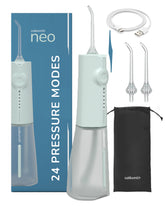How to Use an Electric Toothbrush to Clean Your Teeth
- Better Plaque Removal: Electric toothbrushes are better at removing plaque and food debris from your teeth and gums.
- Consistent Brushing: We can’t speak for everyone, but our electric toothbrushes have a timer for the dentist-recommended 2 minutes and a quadpacer that lets you clean evenly.
- Improved gum health: Vibrations from the brush head stimulate your gums, leading to better circulation, which prevents gum diseases.
- Disability friendly: For people with dexterity problems, like arthritis, an electric toothbrush can do most of the work.
The Preparation
First things first, make sure you have enough charge in your toothbrush. You don’t want to be in the middle of brushing your teeth when it dies on you. After each use, see how much charge is left. Ideally, recharge your toothbrush once it hovers around 20% battery level. If it is a rechargeable toothbrush, use the wire included to recharge your toothbrush. On the other hand, if your brush uses replaceable batteries, simply replace the battery.Also, keep a lookout for how the bristles feel on your teeth. If they feel too rough, it is time to replace them. Using a rough-bristle toothbrush can do more harm than good. We recommend that you change your brush head every three months.
The Correct Technique to Brush Your Teeth with an Electric Toothbrush
Step 1 - Apply toothpaste
Wet the toothbrush and apply a pea-sized amount of toothpaste to the brush head.
Step 2 - Divide into quadrants
Divide your teeth into four quadrants - top, right, bottom & left. Choose whichever you're comfortable with.
Step 3 - Brush outer surfaces
Begin brushing by holding your brush at a 45-degree angle, just like you would with a manual toothbrush. Starting with the outside surfaces of your teeth gently guide the brush head slowly from tooth to tooth. Make sure you hold the brush head in place for a few seconds against each tooth before you move on to the next one. Make sure you follow along with the shape of each tooth and the curve of your gums.
Step 4 - Brush inner surfaces
When you have finished the outer surfaces of your teeth repeat your actions on the inside surfaces, and then again on the chewing surfaces of your teeth. Don’t forget to brush behind your back teeth.
Step 5 - Repeat
Repeat the outer and inner surface brushing with the other three quadrants. Spend 30 seconds at least on each quadrant.
Step 6 - Scrub your tongue
When you have finished brushing your teeth take a few seconds to direct the brush head along your gum line and on your gums. This will help remove any remaining plaque. Be careful not to press too hard when brushing your gums or you may irritate them.
Step 7 - Rinse & Wait
Rinse your mouth with a mouthwash. Wait at least 15-20 minutes before you eat or drink anything. Doing this will give plenty of time for the saliva to remineralize your enamel and help maintain it.
How to Clean & Maintain Electric Toothbrush
Clean your toothbrush and brush head after every use. Do this by rinsing it under water to remove any visible debris. You could also use an antibacterial soap or a toothbrush sanitiser solution to disinfect the head and handle. Once done, store your toothbrush upright to let it air dry before using it again.Adopting such a maintenance routine can help maintain good oral hygiene, prevent the spread of bacteria and infections, and ensure a fresh and more effective brushing every time.
The Conclusion
In conclusion, using an electric toothbrush effectively is the key to maintaining good oral hygiene. By following a proper brushing and maintenance technique, you can ensure your teeth and gums stay healthy.If you’re interested in taking the first step in maintaining the health of your teeth and gums, get yourself one of our Spark range of toothbrushes.
Frequently Asked Questions
1. Do you brush back and forth with an electric toothbrush?
Do not brush back and forth with an electric toothbrush. Instead, gently guide the brush along your teeth and let the oscillating or vibrating motion of the brush head do the cleaning
2. Is an electric toothbrush safe around water?
Most electric toothbrushes have a waterproofing rating to it. So you don’t have to be worried about getting it wet. However, do not dunk it in water for long periods.
3. Is it OK to brush your gums with an electric toothbrush?
Yes, brush your gums gently with an electric toothbrush. Brush along the gum line, but don't press too hard, as this can irritate your gums.
4. Can I use an electric brush to clean my tongue?
Yes. After brushing your teeth, brush your tongue and the roof of your mouth to remove any remaining food particles and freshen your breath.
5. Is it bad to use an electric brush to clean teeth daily?
No! In fact, for great oral hygiene, dentists recommend using an electric toothbrush twice a day, for two minutes.




























